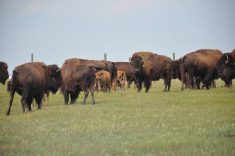RENO, Nev. – Exports present the best opportunity for U.S. beef producers, given that domestic consumption is not increasing and retail prices have reached a peak, according to the chair of the U.S. Meat Export Federation.
“The No. 1 incremental demand opportunity that we have is in the international market place,” Dale Halstrom told a meeting of the international trade committee during the National Cattlemen’s Beef Association convention in Reno Feb. 8.
Halstrom, who is also vice-president of JBS/Swift, said global beef demand is growing but the U.S. faces market access restrictions in some of its prime destinations since BSE was found in the country in 2003.
Read Also

Solar, sheep provide valuable farm diversification
Eric Steeves says raising sheep on forages grown under solar panels provided economic stability and perhaps even saved his family’s fifth generation southern Alberta grain farm.
“We have to look outside our borders for increased growth,” he said.
The federation has a $34 million annual budget with 85 percent devoted to international programs to continue to promote American beef, mostly in Asia.
The United States has been active in Japan for 30 years and had penetrated that market successfully.
Now it is working to rebuild lost consumer confidence and is spending a large share of its budget to promote beef safety.
“We have a long way to go to rebuild that position in Japan and Korea,” said Thad Lively of the federation.
It plans to export three billion pounds of beef in 2010, which is the same goal set in 2003 before many borders closed. About one billion lb. were exported in 2005.
The record year was 2003 when 1.2 million tonnes were exported around the world. That level is equivalent to 60,000 head slaughtered per week.
Cattle producers lost about $75 per head when BSE restrictions were applied. The shortfall occurs when exports of items such as short ribs, tongue and liver are banned. While these are sold for a low price in Canada and the U.S., they command premium prices in Asia.
As other currencies strengthen against the U.S. dollar, opportunities abound for agricultural commodities, providing access is improved.
“The potential is beyond our dreams if our dollar stays low,” said Dan Dierschke, chair of the international markets committee.
While Asia is eyed as a high value market, Canada and Mexico remain the best customers for U.S. beef outside its borders. In 2007, Canada bought 131,500 tonnes of U.S. beef worth $600 million.















